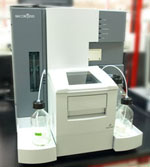GE Biacore 8K, T200 and T100
 Biacore system is a series of Surface Plasmon Resonance (SPR) instruments.
The instrument contains a flow system, a temperature control unit and an optical system to measure the molecular interactions occuring on sensor chips in real-time,
with/without special labeling. This technique is capable for binding kinetics (on/off rate constants), affinity (equilibrium constants)and thermodynamic studies.
Biacore system is a series of Surface Plasmon Resonance (SPR) instruments.
The instrument contains a flow system, a temperature control unit and an optical system to measure the molecular interactions occuring on sensor chips in real-time,
with/without special labeling. This technique is capable for binding kinetics (on/off rate constants), affinity (equilibrium constants)and thermodynamic studies.
 Important Notification:
Important Notification:
* (2025-06-03) Biacore 8K are ready for services.
* (2025-04-28) Biacore 8K is not available due to its valve block failure. Service is called.
* (2020-12-23) Both Biacore T200 and Biacore 8K are ready.
* (2020-12-11) Biacore T200 is not available due to an unknown injection error. Service is called.
(2020-12-01) Sample submission to Biacore 8K is suspended. Sorry for the inconvenience.
(2019-03-01) Biacore 8K is ready for services. Please refer to 8K Sample submission guideline for sample requirements.
(2017-09-06) The temperature control units on both Baicore T200 and T100 are getting old and the cooling rate is not within instrument specification. Temperature below 25℃ is not recommended. Longer waiting time might be required for temperature to stabilize. Please check with Dr. Jao before planning your experiments.
* Please use sealing foils with no glue applied inside of the wells. Otherwise, the needle can get clogged and will not deliver samples correctly.
 Selected Applications
Selected Applications
Binding specificity Binding kinetics Active protein concentration Molecular Recognition Ligand fishing Structure-function Relationship
 Specification
Specification
| Spec. | Biacore T200 | Biacore 8K |
| No. of flow cells | 4 |
8+8 |
| Flow rate | 1 - 100 μl/min |
1 - 100 μl/min |
| Injection volume | 2 - 350 μl |
1 - 200 μl |
| Required volume | injection volume + 20 - 50 μl |
injection volume + 20 - 50 μl |
| Flow cell volume | 0.06 μl |
0.04 μl |
| Sample/reagent capacity | 1x96/384-well plate+33 vials |
4x96/384-well plates |
| Temperature range | 10* to 45 ℃ (*BCF instruments) |
(Room temp. -20) to 40 ℃ |
| Refractive index range | 1.33 - 1.39 |
1.33 - 1.39 |
| Baseline noise | <0.03 RU |
<0.02 RU |
| ka | 1E3 - 3E9/Ms for proteins 1E3 - 5E7/Ms for small molecule |
1E9/Ms for proteins 1E3 - 5E7/Ms for small molecule |
| kd | 1E-5 - 1 /s |
1E-6 - 0.5 /s |
| Sample concentration | >10pM |
>1pM |
| Minimum molecular weight | <100Da |
<100Da |
 Suggested Reading:
Suggested Reading:
Biacore T200 Instrument Handbook. Biacore T200 Software Handbook. Rich RL and Myszka DG, 2008, Survey of the year 2007 commercial optical biosensor literature, J. Mol. Recognit., 21, 355-400. Rich RL and Myszka DG, 2007, Survey of the year 2006 commercial optical biosensor literature, J. Mol. Recognit., 20, 300-366. Schasfoort RBM and Tudos AJ (eds.), 2007, Handbook of Surface Plasmon Resonance. RSC Publishing. Rich RL and Myszka DG, 2006, Survey of the year 2005 commercial optical biosensor literature, J. Mol. Recognit., 19, 478-534. Single-Cycle Kinetics: Karlsson R, Katsamba PS, Nordin H, Pol E and Myszka DG, 2006, Analyzing a kinetics titration series using affinity biosensors, Anal. Biochem., 349, 136-147. Fragment Based Screening / Small Molecules: Anthony M. Giannetti, 2011, From experimental design to validated hits, Methods in Enzymology, 493, 169-218.

